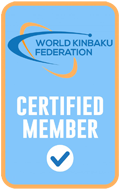FAQ
Frequently Asked Questions
Osada Ryu is the structured tying system (school) developed by Osada Steve in Tokyo based on his years of working as a professional rope artist in Japan, as well as training with some of the Grandmasters of Shibari. It is based on the life works of some of the most famous Bakushis (tying artists) such as Osada Eikichi, Akechi Denki and Yukimura Haruki.
As a teaching system, it focuses on security and communication while facilitating the instruction of even complex techniques by breaking them up into simple, easily understood units that build on one another. It combines technical and philosophical aspects and is the foundation of the skills of a majority of all active Western riggers (tying practitioners).
To determined students it offers the chance to track their learning progress by means of exams. These exams are called “Kyu exams”. Starting at 9th Kyu, they cover the whole curriculum of techniques and the philosophies they are based.
The exams further allow the comparison of skill levels across all Osada Ryu dojos and thereby provide the possibility of seamlessly continuing the training at any of the dojos.
Osada Ryu emphasizes communication and interaction with the passive partner.
Michael Ropeknight was licensed as instructor by Osada Steve and teaches this style at Fourelements.
Yukimura Ryu is the Shibari style developed and taught by the late Grandmaster Yukimura Haruki (1948-2016). This style covers techniques for tying on the ground and also employs a large variety of smaller techniques outside of rope handling. The style is often referred to as “Newaza” and is unique among the traditional Shibari styles. In contrast to the other – oftentimes rougher – tying techniques, it is a softer and more emotional style. Yukimura often referred to it as “aibu no nawa” (caressing rope).
Large focus is placed on communication by means of rope to provoke emotional responses from the model. This emotional dialogue is highly unconventional for the Japanese soul.
Michael Ropeknight was licensed as instructor by Yukimura Haruki and teaches this style at Fourelements.
At Fourelements you can study traditional and progressive Shibari. If you want to find out about Shibari, click here.
Events and lessons take place at Fourelements dojo in the Cologne/Bonn region in the South of North Rhine-Westfalia. The airport Cologne/Bonn is located about 20 minutes away by car. An inexpensive hotel is located within walking distance, but attendees can also spend the night at the dojo if they prefer.
a) Lessons
Michael (Nawakishi) Ropeknight is the only certified instructor of Shibari in the styles of Osada Ryu and Yukimura Ryu in Germany. If you are interested in lessons, please get in touch with him via the contact form on this website.
b) Seilzeit
„Seilzeit“ is a Shibari event that gives people the chance to escape the sometimes hectic everyday life. It provides a safe, quiet environment with soft background music, where people can discuss rope topics, experiment, gain their first experiences with Shibari or just have a pleasant time with friendly and like-minded people.
Everybody is welcome: whether interested or curious, beginner or “professional”, Shibari artists as well as western bondage practitioners, all genders, people just “wanting to tie or be tied” or just “wanting to take a look”.
We extend a special invitation to single people without a tying partner to help to introduce them to the world of Shibari. Friendly conversations with other attendees just might lead to „wanting to experience rope together“.
There is no dress code, but out of respect for the neighbors, we ask attendees to not use „provocative clothing” in the outside areas. In general we recommend to wear comfortable clothing.
Bringing your own ropes as well as a blanket or quilt is recommended. Beginners can also use ropes provided by the dojo.
As the event spans several hours, we ask that everybody bring some food for the buffet. Common choices include vegetarian pasta salad, meatballs, cheese, bread, dips, sweets or basically anything you can think of. This way everybody can contribute to a fun evening.
Hot and cold drinks are provided free of charge by the dojo.
This is a private event. To assure its success, attendees agree to follow the house rules and to participate in contribution to expenses.
c) Seilzeit „kinbaku edition“
This event targets Shibari couples who want to take a deep dive into the world of Kinbaku and wish to experience unforgettable moments.
Tying, the beauty of suffering, dominance and submission, devotion and intense feelings, eroticism and pain – these are the features of this evening.
There is no dress code, but out of respect for the neighbors, we ask attendees to not use „provocative clothing” in the outside areas.
As the event spans several hours, we ask that everybody bring some food for the buffet. Common choices include vegetarian pasta salad, meatballs, cheese, bread, dips, sweets or basically anything you can think of. This way everybody can contribute to a fun evening.
Hot and cold drinks are provided free of charge by the dojo.
This is a private event. To assure its success, attendees agree to follow the house rules and to participate in contribution to expenses.
Osada Ryu is one of the most significant teaching systems in Shibari. To determined students it offers the chance to track their learning progress by means of exams. These exams are called “Kyu exams”. Starting at 9th Kyu, they cover the whole curriculum of techniques and the philosophies they are based. The exams further allow the comparison of skill levels across all Osada Ryu dojos and thereby provide the possibility of seamlessly continuing the training at any of the dojos. They can also be helpful in certifying a rigger’s skill level for new potential models/partners.
Comfortable clothing is recommended for both, active and passive roles.
The Fourelements provides a safe space, where beginners can take their first steps in Shibari. Experienced people are usually available to answer any questions. Especially the „Seilzeit“ events are recommended to beginners. They provide the chance for observation and communication with others and to experience Shibari at one’s own pace.
If you are still unsure, please feel free to contact Michael Ropeknight directly with any questions you might have.
A good starting place is to attend a „Seilzeit“ event. Here you can meet potential partners for Shibari during casual conversations and watching others tie. You are encouraged to keep an open mind regarding genders and not prematurely focusing on active/passive roles. Feel free to sign up for any of the next available events.




